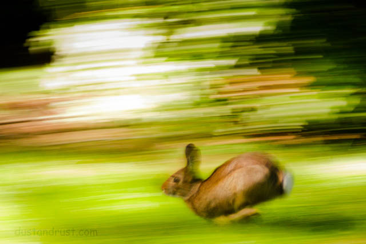
Case 23: Run, Rabbit, Run!
According to the Jataka Tales, once a rabbit was dozing at the foot of a coconut tree when he dreamt that the Earth was breaking up. “Oh, my!” he thought on waking. “What would become of me if that happened?’
At that moment, some monkeys dropped a coconut from the tree. Hearing it shatter on the ground, the rabbit cried out in alarm, “It’s happening! The world is breaking up!” And he began to run and shout.
Soon he came upon another rabbit, who asked what the matter was. Hearing that the Earth was breaking up, that rabbit also began to run and shout.
Soon hundreds of rabbits were running and shouting that the Earth was breaking up. They passed a deer, who began to shout and run. And the deer passed a fox, who began running and shouting. The fox passed an elephant, and soon all the animals of the jungle were running and shouting.
Except for the lion. Hearing that the Earth was breaking up, the king of the jungle wondered if there wasn’t some mistake. So he positioned himself before the stampeding animals and roared three times with all his might, bringing them all to a halt.
“Who says the Earth is breaking up?” he asked the elephant, the largest of the animals. The elephant said he’d heard if from the fox. The fox, in turn, said he’d heard it from the deer, and the deer said the rabbits had told him. Finally, the lion came to the first rabbit, who explained what had happened.
Returning to the tree where the rabbit had dreamed, the lion pointed to the coconut and said, “This is where your madness all began.”
And if it weren’t for the wise lion, the animals might all be running still.
BACKGROUND:
Jataka Takes The Jataka Tales, which are found in the Pali Canon of Theravada Buddhism, chronicle the earlier lives of the Buddha in which he often appears as an animal. The tales probably originated as religious folk stories intended to illustrate some aspect of Buddhist teaching.
The Earth was breaking up The rabbit’s dream taps into a level of primitive existential panic often encountered in dreams. A curious variation on this ancient folk tale is the story of Chicken Little, in which an acorn falls on the main character’s head, convincing him that the sky is falling. In this version, the fox plays the role of the lion. However, instead of offering instruction, he lures the animals back to his lair and eats them.
Rabbit to deer, deer to fox, fox to elephant The relaying of information from the first rabbit to all the other animals of the forest is folkloric shorthand for the way we construct reality in collective social settings. All social groups are bound by common needs and common anxieties. Such groups cooperate to fulfill their basic needs and this is called an economy. But groups also cooperate to sustain levels of basic panic. These are rarely examined, and almost never traced back to their source, as the wise lion does in the story, restoring the animal community to sanity once again.
The wise lion The lion represents the Buddha, whose sobriety and concern for the welfare of others leads him to investigate the causes of fear and suffering and, in so doing, to overcome them.
COMMENTARY:
The popular World War II song, “Run Rabbit Run,” written in 1939 at a time when most London theatres were closed due to the bombings, reads as follows:
On the farm, every Friday
On the farm, it’s rabbit pie day.
So, every Friday that ever comes along,
I get up early and sing this little song
Run rabbit – run rabbit – Run! Run! Run!
Run rabbit – run rabbit – Run! Run! Run!
Bang! Bang! Bang! Bang!
Goes the farmer’s gun.
Run, rabbit, run, rabbit, run.
Run rabbit – run rabbit – Run! Run! Run!
Don’t give the farmer his fun! Fun! Fun!
He’ll get by
Without his rabbit pie
So run rabbit – run rabbit – Run! Run! Run!
Whether the Earth is breaking apart, the sky is falling, or the plaster is coming down from the ceiling with the rumble of a distant bomb, the “Rabbit Mind” says, “Run!” No wonder the song was so popular!
But why? What have we been told that makes us run without stopping from one moment to the next? There is only one way to answer that question, and that’s to stop and retrace our steps. The answer doesn’t lie in more running. The answer is turning back.
VERSE:
Awful as it is
To run uninterrupted
Never knowing why,
At least it invites a buddha
To turn us in our tracks!
Image: dustandrust.com
Thank you for subscribing to Tricycle! As a nonprofit, we depend on readers like you to keep Buddhist teachings and practices widely available.